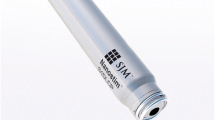Summary
Automatic testing of the ventricular pacing threshold and adjustment of the pacing output are desirable properties of modern pacemakers designed to save energy, prolong battery lifetime and enhance pacing safety. The Medtronic Capture Management™ algorithm fulfills these criteria independently of lead polarity and lead polarization amplitude. Our initial experience in 38 paced patients with congenital heart disease with transvenous leads is reported. The age at pacemakerimplantation was 11.59 (2.72–63.7) years, follow-up after lead implantation was 1.49 (0.01–9.39) years and threshold voltage 0.5 (0.25–2.0) V at a pulse width of 0.4 (0.21–1.0) ms. The default limits of Capture Management™ were left unchanged initially and adjusted individually during follow-up. A correct adaptive Capture Management™ function was observed in all patients. Due to a high pacing threshold late deactivation was necessary in 1 patient.
Conclusion
In the complex and inhomogenous patient group with congenital heart disease the Capture Management™ algorithm allows safe adjustment of the pacing energy according to the actual pacing threshold using transvenous leads.
Zusammenfassung
Algorithmen zur automatischen Bestimmung der ventrikulären Reizschwelle mit konsekutiver Anpassung der Stimulationsenergie sind wünschenswerte Eigenschaften moderner Herzschrittmacher, um Energie zu sparen, die Batterielaufzeit zu verlängern und die Stimulationssicherheit zu erhöhen. Der Medtronic Capture Management™ Algorithmus erfüllt diese Kriterien unabhängig von der Polarität und dem Polarisationssignal der Elektroden. Es wird über unsere initiale Erfahrung bei 38 transvenös stimulierten Patienten mit einem angeborenen Herzfehler berichtet. Das Alter bei Schrittmacherimplantation betrug 11,59 (2,72–63,7) Jahre, das Follow-up nach Elektrodenimplantation war 1,49 (0,01–9,39) Jahre und die Reizschwelle wurde mit 0,5 (0,25–2,0) V bei einer Impulsbreite von 0,4 (0,21–1,0) ms bestimmt. Die einwandfreie adaptive Capture-Management™-Funktion konnte bei allen Patienten nachgewiesen werden. Wegen einer hohen Reizschwelle musste der Agorithmus nur bei einem Patienten spät deaktiviert werden.
Schlussfolgerung
Bei transvenös stimulierten Patienten mit angeborenem Herzfehler kann der Capture-Management™-Algorithmus die tägliche Überwachung der ventrikulären Reizschwelle mit konsekutiver Anpassung der Stimulationsenergie sicherstellen und dadurch die Stimulationssicherheit für diese komplexe und inhomogene Patientengruppe verbessern.
Similar content being viewed by others
References
Ashida Y, Kuroda H, Ishiguro S, Hamasaki T, Kamihira S, Ono K et al (2001) A case of permanent pacemaker implantation in small infant using steroid-eluting epicardial pacing lead: changes of the pacing threshold in acute phase. Kyobu Geka 54(7):596–598
Bauersfeld U, Nowak B, Molinari L, Malm T, Kampmann C, Schonbeck MH et al (1999) Low-energy epicardial pacing in children: the benefit of autocapture. Ann Thorac Surg 68(4):1380–1383
Bertram H, Jux C, Bökenkamp R, Windhagen-Mahnert B, Paul T (2001) Herzschrittmachertherapie bei Kindern. Mittelfristige Erfahrungen mit epikardialer Autocapture-Stimulation. Z Kardiol 90(9):703 (abstract)
Bertram H, Paul T, Fink C, Peuster M, Steinhoff G, Hausdorf G (1998) Epikardiale Stimulation im Autocapture-Modus: Erfahrungen mit einem neuen Schrittmacherkonzept. Z Kardiol 87(9):738 (abstract)
Bondke H, Schoefeld G, Eiesert C, Baumann G (2001) Longevity increase of cardiac pacemakers using capture management. Eur Heart J (Suppl):445 (abstract)
Bondke H, Schoenfeld G, Witte J, Baumann G (2002) Capture Management—ein nutzbares Instrument der Schrittmacher-Therapie? Herzschrittmachertherapie und Elektrophysiologie 13(Suppl 1):I/93–I/94
Clarke M, Liu B, Schuller H, Binner L, Kennergren C, Guerola M et al (1998) Automatic adjustment of pacemaker stimulation output correlated with continuously monitored capture thresholds: a multicenter study. European Microny Study Group. Pacing Clin Electrophysiol 21(8):1567–1575
Cohen MI, Buck K, Tanel RE, Vetter VL, Rhodes LA, Cox J, Sheldon T, Ruetz L (2004) Capture management efficacy in children and young adults with endocardial and unipolar epicardial systems. Europace 6(3):248–255
Gelvan D, Crystal E, Dokumaci B, Goldshmid Y, Ovsyshcher IE (2003) Effect of modern pacing algorithms on generator longevity: a predictive analysis. Pacing Clin Electrophysiol 26(9):1796–1802
Jones BR, Kim J, Zhu Q, Nelson JP, KenKnight BH, Lang DJ et al (1999) Future of bradyarrhythmia therapy systems: automaticity. Am J Cardiol 83(5B):192D–201D
Nowak B, Bauersfeld U, Fahraeus T, Rahn M, Schüller H (2000) DDD pacing based on ventricular “Autocapture” in children. Eur Heart J 21(9):435 (abstract)
Nuernberg JH, Ewert P, Abdul-Khaliq H, Rützler K, Peters B, Lange PE (2002) Schrittmachertherapie bei angeborenen Herzfehlern: Erfahrungen mit Algorithmen zur automatischen Reizschwellenbestimmung. Herzschrittmachertherapie und Elektrophysiologie 13(Suppl 1):I/95–I/96
Nuernberg JH, Yigitbasi M, Rammes S, Abdul-Khaliq H, Lange PE (2002) Schrittmachertherapie: Vergleich zweier Algorithmen zur automatischen Reizschwellenüberprüfung und Anpassung der Stimulationsenergie. Z Kardiol 91(9):768 (abstract)
Nuernberg JH, Alexi-Meskishvili V, Berger F, Daehnert I, Lange PE (2001) Unconventional approach to cardiac pacing: transatrial lead placement in a patient with fontan circulation and complex arrhythmias (case report). Cardiol Young 11(Suppl 1):313–314 (abstract)
Nuernberg JH, Abdul-Khaliq H, Ewert P, Lange PE (2003) Antibradycardia pacing in patients with congenital heart disease: experience with automatic threshold determination and output regulation (autocapture). Europace 5(2):199–205
Peck B (1998) Current concepts in autocapture. Technical Concept Paper. Minneapolis, MN, Medtronic, Inc
Peck B (1998) Ventricular capture management operational details. Technical Concept Paper. Minneapolis, MN, Medtronic, Inc
Preston TA, Fletcher RD, Lucchesi BR, Judge RD (1967) Changes in myocardial threshold. Physiologic and pharmacologic factors in patients with implanted pacemakers. Am Heart J 74(2):235–242
Simeon L, Duru F, Fluri M, Jenzer HR, Rahn M, Candinas R (2000) The impact of automatic threshold tracking on pulse generator longevity in patients with different chronic stimulation thresholds. Pacing Clin Electrophysiol 23(11 Pt 2):1788–1791
Suri R, Harthorne JW, Galvin J (2001) Automatically optimizing pacing output: an excellent idea, but with potentially lethal pitfalls. Pacing Clin Electrophysiol 24(4 Pt 1):520–523
Author information
Authors and Affiliations
Corresponding author
Rights and permissions
About this article
Cite this article
Nürnberg, JH., Ovroutski, S., Yigitbasi, M. et al. Capture Management™ in transvenously paced patients with congenital heart disease. Z Herz- Thorax- Gefäßchir 19, 25–31 (2005). https://doi.org/10.1007/s00398-005-0484-2
Received:
Accepted:
Issue Date:
DOI: https://doi.org/10.1007/s00398-005-0484-2




